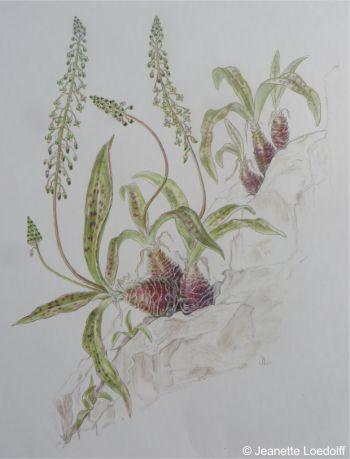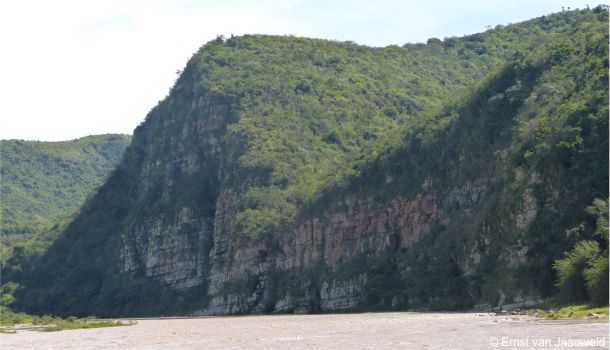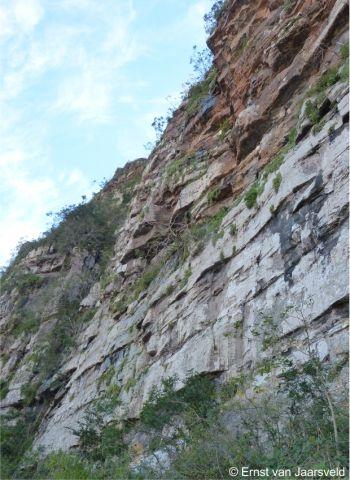Ledebouria loedolffiae
Ledebouria loedolffiae Van Jaarsv. & Venter
Family: Hyacinthaceae
Common names: spotted cliff African hyacinth, spotted cliff squill (Eng.), kransbontblaar (Afr.)
Introduction
Ledebouria loedolffiae is a cluster-forming, evergreen, bulbous plant with mottled leaves in a rosette and small purplish flowers carried on an ascending raceme in spring. It grows on cliffs in the dry summer-rainfall Eastern Cape, with the bulbs usually above the substrate. Best grown in containers.

Fig. 1. The spotted cliff squill (Ledebouria loedolffiae) growing in habitat along the Mbashe River, Eastern Cape. Note the various species of lichen growing on the Beaufort Shale rocks.
Description
Description
The bulb tapering, up to 35 x 16 mm, growing above the substrate, at first solitary, forming clusters up to 90 mm in diameter and consisting of up to 8 individuals. The bulb scales or tunics are dark purple, drying to brownish, transparent, firm leathery, bearing distinct ridged transverse abscission layer. The roots to 1–2 mm in diameter, fleshy, often swollen to 4.5 mm at the ends. The leaves 2–3, ascending spreading, fleshy, linear-lanceolate, 40–85 x 9–16 mm; base amplexicaul, smooth and without hairs (glabrous), green, obscurely darker spotted, when severed with threadlike strings. The upper surface green, sometimes faintly spotted in the centre and towards the base, the margin entire, pointed at the tips and becoming slightly channelled. The inflorescence 80–125 mm, the stalk of the inflorescence rounded (terete), 50–80 mm long, 1 mm in diameter at the base. The raceme 25–50 mm, with up to 10 flowers open at the same time. The flowers spreading and nodding, with small, upward curving, subulate bracts. The flower stalks maroon, 2.5–5 mm, the tepals green, triangular-ovate, 4 x 1.5 mm, soon becoming reflexed. They are sharply pointed at the tips (acute). The stamens purplish, with cream pollen. The ovary 6-lobed, grooved, green stalked, 1.3 mm high, 1.9 mm in diameter, green, on short pedicle 0.5 mm. The female portion (stigma) 3 mm, translucent. Flowering time is in spring (September to October, southern Hemisphere).

Fig. 2. An illustration of Ledebouria loedolffiae by Jeanette Loedolff, drawn from plants gathered north-east of Willowmore, Eastern Cape.
Conservation Status
Status
Plants are widespread and this species is not threatened.
Distribution and habitat
Distribution description
Ledebouria loedolffiae grows wild on cliffs in river gorges in the Eastern Cape Province both in thicket and the savannah biomes. It is only known from Campherspoort, north-east of Willowmore and from cliffs along the Mbashe River in the east.

Fig. 3. The cliffs along the Mbashe River, habitat of Ledebouria loedolffiae.
At Campherspoort, Ledebouria loedolffiae was observed growing on quarzitic sandstone ledges of south-facing cliffs at an altitude of about 800 m above sea level. Associated species include Haworthiopsis glauca var. herrei, Haworthia zantneriana, Cotyledon woodii, Crassula pellucida subsp. marginalis, Crassula perfoliata var. minor, Bulbine latifolia and Bulbine rupicola. The vegetation at Campherspoort consists of Groot Thicket. Along the Mbashe River, at the eastern extreme where there is higher rainfall, the subtropical vegetation consists of Eastern Valley Bushveld (Savannah Biome) and plants grow at an altitude of between 100 and 200 m above sea level on Beaufort Shale cliffs. Ledebouria loedolffiae was seen growing on south-facing cliffs together with Crassula rupestris, Haworthia cymbiformis var. setulifera, Bulbine latifolia, Rhipsalis baccifera, Cotyledon petiolaris, Crassothonna capensis, Tetradenia barberae, Chlorophytum comosum, Coleus madagascariensis, Crassula intermedia, Delosperma laxipetalum, Pelargonium acraeum and Bowiea volubilis.
The climate in the habitat of Ledebouria loedolffiae is subtropical, and can become very hot in summer, reaching over 40°C. The winters are cooler but frost is absent in the cliff habitat. Rainfall occurs during summer, between October and April, in the form of convectional thundershowers . Rainfall may also be experienced in winter due to cyclonic cold fronts from the south. Annual rainfall ranges between 150 and 400 mm.

Fig. 4. The cliff face along the Mbashe River, habitat of many succulents and Ledebouria loedolffiae.
Derivation of name and historical aspects
History
Ledebouria loedolffiae was named by Fanie Venter and the author in 2017 in the botanical journal Avonia, from plants collected north-east of Willowmore. It honours the botanical artist Jeanette Loedolff, in recognition of her contribution to botanical art and the conservation of indigenous plant species in southern Africa such as Gasteria and many cliff dwelling succulents and bulbous plants. She was appointed the botanical artist for the National Botanical Gardens in 1982 and remained until her retirement in 2002. She is a life member of the Botanical Artist Association of Southern Africa (BAASA). Jeanette Loedolff has been awarded the Botanical Society’s prestigious Cythna Letty Medal in 2014 for her outstanding art work. She is also commemorated in Gasteria loedolffiae. The plant was drawn by Jeanette (see Fig. 2) as well as two visiting botanical artists, Myriam Schmaus and Gillian Forster (see Figs. 5 & 6).
.jpg?itok=RUOJm1wY)
Fig. 5. An illustration of Ledebouria loedolffiae by Gillian Forster, drawn from plants gathered north-east of Willowmore, Eastern Cape.
Ledebouria loedolffiae is related to L. socialis, both are evergreen and bulbs grow above the substrate. The latter grows in the shade of dense thickets with distinctly mottled leaves whilst L. loedolffiae is only known from cliffs and has faintly spotted leaves. Further, the bulbs of L. loedolffiae are smaller that those of L. socialis, the tunics firmer and leathery, the inflorescence ascending and the tepals larger, fused at the base and only reflexed in the upper half.
The genus Ledebouria, commonly called African hyacinth or squill (Family Hyacinthaceae) are semi-succulent bulbous plants mainly grown for their beautifully ornamented leaves. They are widely distributed in sub-Saharan Africa, India and Madagascar but the greatest diversity is found in the higher lying grassland and savanna regions of South Africa (Manning et al 2002, Manning & Goldblatt 2003). Ledebouria socialis is grown world-wide as an indoor pot plant. Ledebouria honours Carl Friedrich van Ledebour (1785-1851), a German-Estonian professor of botany at Tartu, Estonia (Jackson 1990, Clarke et. al. 2016). It was named by the Swedish botanist Joran Johansson Rothman (1739-1778), a student of Linnaeus.

Fig. 6. An illustration of Ledebouria loedolffiae by Myriam Schmaus (spring 2013), drawn from plants gathered north-east of Willowmore, Eastern Cape.
Ecology
Ecology
Ledebouria loedolffiae is a drought tolerant plant, the fleshy bulb scales store sufficient moisture to carry the plant through dry periods. The bulb grows above the substrate and the leaves are in an apical rosette, this enables the plant to maximise photosynthesis. The plant proliferates from the base forming clusters.
The small purplish flowers are pollinated by insects. The fruiting capsules ripen in summer, this coincides with the start of the summer rainfall thus seeds are released while moisture is available. The small seeds are dispersed in the vicinity of the plant.
Unlike many Ledebouria species which are subject to grazing and veld fires, Ledebouria loedolffiae grows on a site that is protected from fires and most herbivores.

Fig. 7. The fleshy roots of a Ledebouria loedolffiae plant grown in the succulent nursery, Kirstenbosch National Botanical Garden.
Growing Ledebouria loedolffiae
Grow
Ledebouria loedolffiae can both be grown as an indoor plant in a container or as a garden plant in dry rockeries where frost is not too severe. It is best grown on embankments and rocky terraces in bushveld and thicket gardens (Van Jaarsveld 2010). The soil should be well drained and the plant planted where there is little competition from other aggressive-growing plants. It is best grown in well-drained soil with ample compost added. They can be grown in full sun or light shade. The plants should proliferate forming small clusters. Plants can be seen growing in the indigenous garden at Babylonstoren Farm near Klapmuts in the Western Cape.
Plants are easily multiplied by sowing of seeds or division of clusters.Sow seed in summer or autumn in a sandy, well-drained soil, such as a mixture consisting of 2 parts sand or gravel, 1 part loam and 1 part compost. Cover the seed with a thin layer of sand (1-2 mm thickness). As a rule of thumb seed can be covered twice the diameter of the seed. First moisten the medium and once sown, the seed will stick to the substrate. Cover them with the sand. Keep moist. Germination is within 3 weeks and once well rooted transfer to individual containers. These can be planted out into individual containers as soon as they are big enough to handle. When grown as a pot plant, make use of the same soil mixture. Once the plant gets growing, add a mild organic fertiliser such as a seaweed-based fertilizer or well broken down compost. As a pot plant it would be best suited to a sunny balcony or windowsill.
References
- Baker, J.G. 1897. Liliaceae. In W.T. Thiselton-Dyer, Flora capensis 6: 253–528. Reeve, London.
- Clarke, H. & Charters, M. 2016. The illustrated dictionary of southern African plant names. Flora & Fauna Publications Trust, Jacana, Johannesburg.
- Christenhusz, M.J.M., Fay, M.F. & Chase, M.W. 2017. Plants of the World, an illustrated Encyclopedia of vascular plants. Kew Publishing, Royal Botanic Gardens, Kew.
- Jackson, W.P.U. 1990. Origins and meanings of names of South African plant genera. University of Cape Town.
- Manning, J.C. & Goldblatt, P. 2003. Ledebouria in G. Germishuizen & E.N.L. Meyer (eds), Plants of Southern Africa: an annotated checklist. Strelitzia 14: 133-136. National Botanical Institute.
- Manning, J., Goldblatt, P. & Snijman, D. 2002. The color encyclopedia of Cape bulbs. Timber Press, Cambridge.
- Mucina, L. & Rutherford, M.C. (eds) 2006. The vegetation of South Africa, Lesotho and Swaziland. Strelitzia 19. South African National Biodiversity Institute, Pretoria.
- Smith, C.A. 1966. Common names of South African plants. Memoirs of the Botanical Survey of South Africa No. 35. Government Printer, Pretoria.
- Van Jaarsveld, E.J. & Venter, S. 2017. Ledebouria loedolffiae, a new cliff-dwelling semi-succulent bulb species from the Eastern Cape. Avonia 35(3):124-139.
- Van Jaarsveld, E.J. 2010. Waterwise gardening in South Africa and Namibia. Struik, Cape Town.
- Venter, S. 1993. A revision of the genus Ledebouria Roth (Hyacinthaceae) in South Africa. Unpublished M.Sc. thesis, University of Natal, Pietermaritzburg.
- Venter, S. 2008. Synopsis of the genus Ledebouria Roth (Hyacinthaceae) in South Africa. Herbertia 62
Credits
Ernst van Jaarsveld
Kirstenbosch National Botanical Garden (Retired 2015)
Babylonstoren Farm
Extraordinary senior lecturer and researcher,
Department of Biodiversity and Conservation, University of the Western Cape
January 2024
Acknowledgements: the author thanks Jeanette Loedolff, Myriam Schmaus and Gillian Forster for preparing the illustrations.
Plant Attributes:
Plant Type: Bulb
SA Distribution: Eastern Cape
Soil type: Sandy, Loam
Flowering season: Spring
PH: Acid, Neutral
Flower colour: Green, Purple
Aspect: Shade, Morning Sun (Semi Shade), Afternoon Sun (Semi Shade)
Gardening skill: Easy
Special Features:
Horticultural zones










Rate this article
Article well written and informative
Rate this plant
Is this an interesting plant?
Login to add your Comment
Back to topNot registered yet? Click here to register.